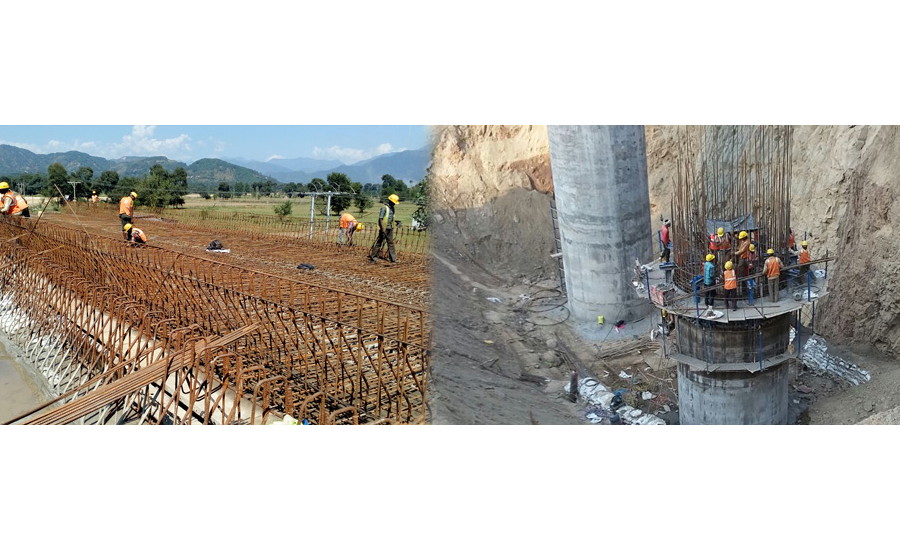Transportation
India Constructs Mountain Highway Tunnels Near Border With Pakistan
Single-tube, bidirectional tunnels will connect winter and summer capitals in Jammu and Kashmir

The project in northern India’s mountainous region utilized drill and blast excavation as well as the New Austrian Tunneling Method.
Images Courtesy Leighton Asia
To strengthen the road network in Jammu and Kashmir, its northern state that borders Pakistan, India in the next two years plans to start road construction projects valued at more than $1 billion in total. Nitin Gadkari, road transport and highways minister, confirmed this recently at the launch of South Asia's longest single-tube, bidirectional tunnel.
Prime Minister Narendra Modi inaugurated the $560-million tunnel on April 2. The link was built at an elevation of 1,200 meters, or 4,000 ft, on the treacherous terrain of the lower Himalayan mountain range. It is part of the Jammu and Kashmir National Highway project's 286-kilometer-long four-laning, which will connect the winter and summer capitals, Jammu and Srinagar, respectively. The project will cut the distance between the two cities to 238 km from 288 km. It is designed to ensure an all-weather passage on a route that often sees heavy traffic jams and disruptions due to landslides, snow, sharp curves, vehicular breakdowns and accidents.
Challenges faced over six years of construction include treacherous weather, access, security and logistics issues. Maintaining employee morale was also an issue.
The Chenani-Nashri tunnel is part of a National Highway Authority of India project along the National Highway 44. Infrastructure Leasing & Financial Services Ltd. contracted the job to Leighton Asia, part of CIMIC Group construction company CPB Contractors. The contractor used the drill-and-blast method of excavation and turned to the New Austrian Tunneling Method (NATM) for stability.
GEODATA provided the detailed design and construction supervision. The 10.9-km highway includes two 9-km tunnels; a 50-meter-long, single-span bridge with 600 m of embankments and slope cuttings; and a 40-m-long, single-span bridge with 2 km of surface works. The main tunnel is connected to an escape tunnel via a 300-m pedestrian passage. There are vehicular crossovers every 1.2 km, with a 9.35-m-wide lane and having a 5-m vertical clearance.
Leighton's work assignment included civil, structural, mechanical, lighting, supervisory control and data acquisition (SCADA), fire control, ventilation and communication works.
According to Gadkari, the tunnel's purpose is to facilitate all-weather transit since the road is closed for an average of 40 days in winter. The tunnel is India's first and the world's sixth road tunnel with a transverse ventilation system. High-power drives and motors run the ventilation system with specialized ABB safety software.
Sterling & Wilson Ltd. designed and installed a two-tier illumination system, which will be operational around the clock, 365 days a year. To ensure smooth travel and safety of commuters, ABB designed, engineered and supplied a low-harmonics, variable-speed-drive (VSD) ventilation system. The VSDs and motors are installed at the north (Nashri) and south (Chenani) portals for air supply and exhaust. These VSDs also are equipped with in-built redundancy to ensure minimum downtime, according to the owner.
"We are providing the muscles and lungs for this critical new tunnel," said Sanjeev Sharma, CEO and managing director at ABB India. The tunnel's safety controls are designed to effectively mitigate any fire emergencies, he added.
In December 2016, ABB built a powerful ventilation system for the world's longest (57 km) and deepest (8,000 ft, at maximum depth) tunnel, the Gotthard Base Tunnel, in Switzerland. To prevent diminution of vision because of changes in the light while going in or coming out of the tunnel, the lighting inside has been adjusted at a gradient of luminous strength.
"Technologically, this is one of the most advanced road tunnels built in the country, surmounting challenges of terrain and distance," said Subir Pal, president of robotics and motion for ABB India.
